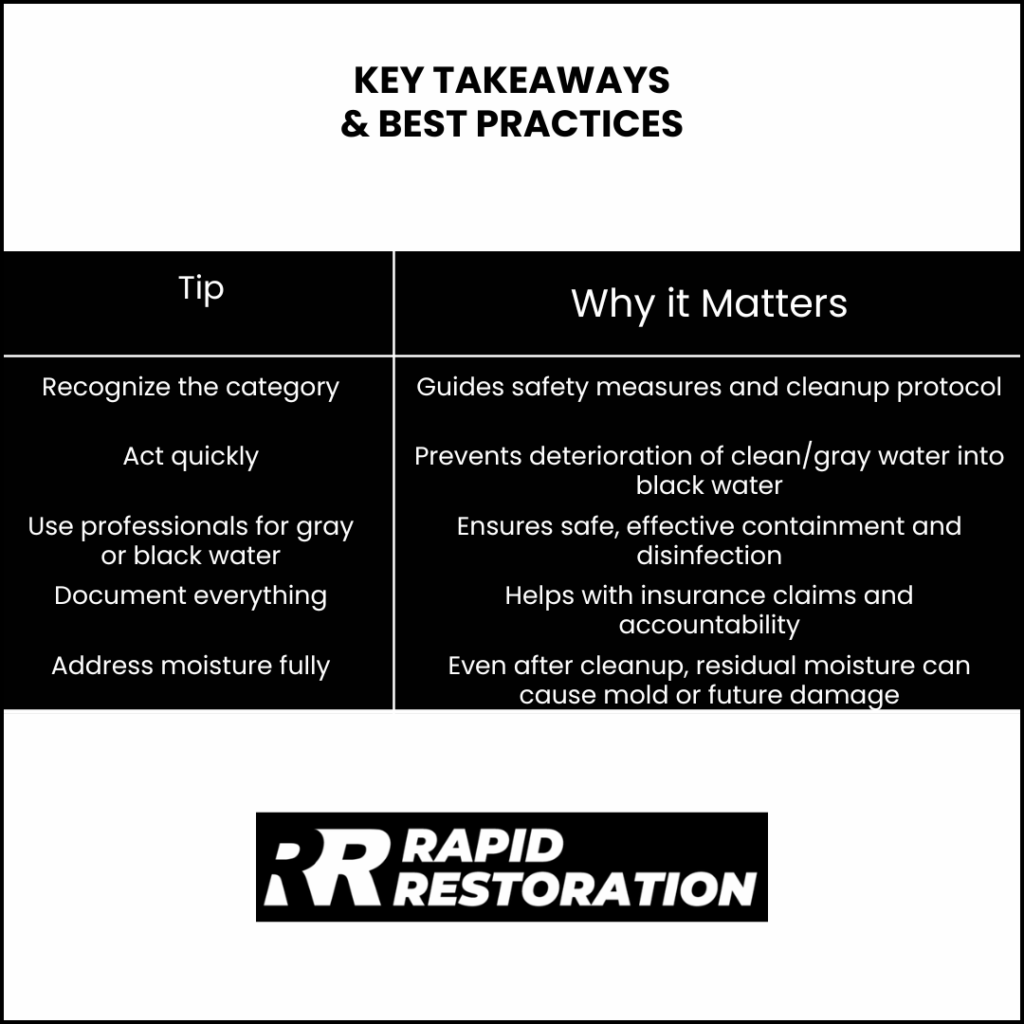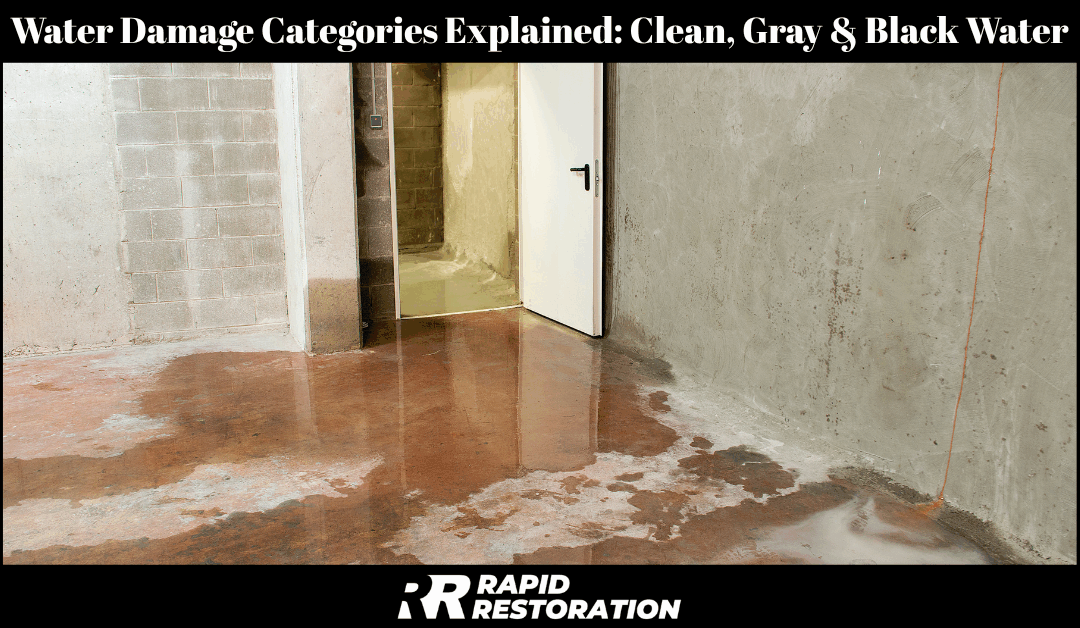When water damage strikes your property, not all water is created equal. The level of contamination in the water affects risk, cleanup methods, and cost. In the restoration industry, water damage is divided into three categories — clean water, gray water, and black water — and understanding these water damage categories is vital for homeowners, building managers, and restoration professionals. In this article, we’ll break down each category, explain how “black water cleanup” differs from lighter cases, and show how Rapid Restoration approaches each scenario.
Why Categories Matter
Categorizing water damage isn’t just semantics — it shapes how cleanup is done, what materials can be salvaged, and what safety precautions are needed. Insurance adjusters, restoration technicians, and property owners all rely on these classifications when assessing damage and planning remediation.
The standard reference is the IICRC S500 (Institute of Inspection, Cleaning and Restoration Certification) for professional water restoration, which defines water in three categories based on contamination levels. Additionally, water that begins as a lower category can deteriorate into a higher category over time or through contact with contaminants.
Category 1: Clean Water (Sanitary Water)
Definition & Sources
Category 1, often called “clean water,” originates from a sanitary source and does not immediately pose a health threat through ingestion, inhalation, or skin contact. Common sources include:
- Broken water supply lines or plumbing (fresh pipe leaks)
- Overflow from sinks, tubs, or faucets (without contaminants)
- Rainwater intrusion (roof leaks, broken gutters)
- Melting snow or ice
Risks & Progression
While the water itself is uncontaminated, it can become unsafe quickly if left standing. After 24–48 hours, microorganism growth may raise contamination levels, converting Category 1 water into Category 2 or even Category 3. Also, contact with dirty surfaces or materials may introduce contaminants.
Cleanup & Restoration Strategy
Because Category 1 water is relatively benign initially, the goal is remediation before it escalates:
- Stop the source (shut off water, fix leaks)
- Remove standing water using pumps or vacuums
- Dry and dehumidify the area using air movers, dehumidifiers, and drying protocols
- Monitor moisture levels until building materials reach acceptable dryness
- Sanitize surfaces if needed (though less aggressive disinfectants are typically sufficient)
Many materials, like drywall, carpeting, and baseboards, can often be saved if drying is prompt and thorough.
Category 2: Gray Water (Significantly Contaminated)
Definition & Sources
Category 2, or “gray water,” contains substantial contamination. It is not overtly hazardous like black water, but it can cause discomfort or sickness if ingested or contacted. Examples include:
- Overflow from dishwashers, washing machines
- Toilet overflow with urine (but no feces)
- Seepage or leakage from moderate sources
- Seepage from hydrostatic pressure
- Broken aquariums or punctured waterbed
Risks & Escalation
Gray water may contain chemicals, food residues, detergents, or microorganisms. Without prompt treatment, gray water can escalate to black water, either through further contamination or by time alone. Because of its moderate contamination, precautions like wearing gloves, masks, or eye protection are prudent.
Cleanup & Restoration Strategy
Compared to clean water, gray water needs more careful handling:
- Personal protective equipment (PPE): Gloves, masks, eye protection, possibly gowns
- Water extraction & drying: Quickly remove water and ventilate
- Cleaning & disinfection: Use antimicrobial agents, especially on surfaces that held standing water
- Removal of some materials: Porous items such as carpet padding, upholstered furniture, and porous drywall often must be removed, cleaned, or replaced
- Testing & monitoring: Verify that microbial levels are controlled
Restoration professionals will often separate contaminated and uncontaminated zones to prevent cross-contamination.
Category 3: Black Water (Grossly Contaminated)
Definition & Sources
Black water (Category 3) is the most dangerous category. It is grossly contaminated and can include pathogens, toxins, and hazardous agents. Direct exposure can cause serious illness. Typical sources include:
- Sewage backups
- Toilet overflows containing fecal matter
- Floodwater from rivers, streams, or storm surge
- Groundwater intrusion carrying pollutants
- Stagnated water that’s been left untreated too long
Because of its extreme risk, black water cleanup requires specialized handling and is not a DIY job for the average homeowner.
Health Risks
Black water may carry bacteria (E. coli, Salmonella), viruses, parasites, chemicals, and biohazards. Exposure can lead to gastrointestinal illnesses, infections, respiratory issues, and more.
Cleanup & Restoration Strategy
Restoration professionals follow a strict protocol for black water cleanup:
- Containment & isolation: Seal off affected zones to prevent cross-contamination
- Full PPE for technicians: Protective suits, respirators, gloves, boot covers
- Extraction & safe disposal: Use industrial pumps and extractors; dispose contaminated water per local regulations
- Demolition & removal: Remove porous materials like drywall, insulation, carpeting, and often baseboards and subflooring
- Disinfection & deodorization: Apply potent antimicrobials, foggers, and odor control systems
- Reconstruction & restoration: Once sanitized and dried, rebuild walls, flooring, and finishes
- Post-remediation testing: Confirm that surfaces are safe and moisture is within acceptable limits
Black water cleanup demands rigorous standards to protect occupants and workers alike.
How Categories Can Change Over Time
It’s vital to understand that water damage is dynamic. A Category 1 event that is not promptly addressed can deteriorate into Category 2 or Category 3. Factors such as temperature, time, contact with contaminants, and microbial growth all contribute. This is one reason that response speed is so critical.
Insurance & Coverage Considerations
Insurance policies often distinguish coverage based on water damage category. Generally:
- Category 1 (clean water) incidents are more likely to be covered if they result from sudden, accidental events (e.g. burst pipes).
- Category 2 and 3 events may face stricter scrutiny, exclusions, or additional deductibles. Sewer backups or flood events (common sources of black water) often require riders or separate flood insurance.
- Detailed documentation, moisture logs, and professional drying reports can help substantiate claims.
If you ever work with insurance adjusters, understanding the water damage categories helps you interpret damage estimates, negotiate repairs, and ensure proper scope of work.
Why Professional Help Matters (Especially for Black Water Cleanup)
Trying to handle water damage — especially black water cleanup — without professional training and equipment is risky and often counterproductive. Certified restoration firms (such as Rapid Restoration) bring:
- Expertise in damage assessment and categorization
- Proper PPE and containment protocols
- Industrial drying, extraction, and dehumidification tools
- Knowledge of antimicrobial agents and odor control
- Experience working with insurance companies
- Compliance with health and safety regulations
In short: when the contamination is significant, it’s not worth cutting corners.
Key Takeaways & Best Practices

If you ever find yourself asking, “Is this just a clean water issue, or do I need black water cleanup?” It’s smart to err on the side of caution and call a professional. For residents or businesses in need of expert guidance, Rapid Restoration is ready to help diagnose the situation and restore your property safely and efficiently.
Need help now?
If water damage has occurred — clean, gray, or black — don’t wait. Contact Rapid Restoration at (631) 201-0077. Our certified technicians provide 24/7 emergency response, advanced drying systems, and dependable black water cleanup services to get your property back to safe, dry, healthy condition.

